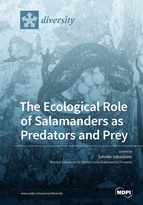The Ecological Role of Salamanders as Predators and Prey
A special issue of Diversity (ISSN 1424-2818). This special issue belongs to the section "Animal Diversity".
Deadline for manuscript submissions: closed (31 December 2021) | Viewed by 33556
Special Issue Editor
Interests: amphibians; salamanders; Plethodontidae; trophic ecology; subterranean ecology; population dynamics
Special Issues, Collections and Topics in MDPI journals
Special Issue Information
Dear Colleagues,
Salamanders are relevant components of many terrestrial and aquatic ecosystems. For example, in fishless streams, larval or adult salamanders act as top predators, while in temperate forests, these amphibians act as mid-level predators that regulate the abundance and diversity of the invertebrate soil fauna and indirectly influence the degradation of the leaf litter. Salamanders may also be present in underground habitats (i.e., caves and the surronding subterranean network), which are among the least studied and most fragile ecosystems of the world. Salamanders are usually considered to be generalist predators at the population level, but they also display specialization at the individual level, in particular when prey resources available in the environment become more diverse. In addition, salamanders and newts have complex behaviors, bright colors, and are easy to maintain in captivity. Therefore, these amphibians are often used as model systems to better understand prey–predator interactions and the evolution of cryptic or aposematic defensive colorations, both in the wild and in the laboratory. This Special Issue provides an opportunity to highlight new research on the ecological role of salamanders and newts in prey–predator systems, their trophic behavior, and the evolution of their trophic niche in space and time. Particularly welcome are studies that describe the evolution of the antipredator behavior, individual trophic specialization, and the trophic strategies of single salamander species or complex multispecies guilds.
Prof. Salvidio Sebastiano
Guest Editor
Manuscript Submission Information
Manuscripts should be submitted online at www.mdpi.com by registering and logging in to this website. Once you are registered, click here to go to the submission form. Manuscripts can be submitted until the deadline. All submissions that pass pre-check are peer-reviewed. Accepted papers will be published continuously in the journal (as soon as accepted) and will be listed together on the special issue website. Research articles, review articles as well as short communications are invited. For planned papers, a title and short abstract (about 100 words) can be sent to the Editorial Office for announcement on this website.
Submitted manuscripts should not have been published previously, nor be under consideration for publication elsewhere (except conference proceedings papers). All manuscripts are thoroughly refereed through a single-blind peer-review process. A guide for authors and other relevant information for submission of manuscripts is available on the Instructions for Authors page. Diversity is an international peer-reviewed open access monthly journal published by MDPI.
Please visit the Instructions for Authors page before submitting a manuscript. The Article Processing Charge (APC) for publication in this open access journal is 2600 CHF (Swiss Francs). Submitted papers should be well formatted and use good English. Authors may use MDPI's English editing service prior to publication or during author revisions.
Keywords
- Salamanders
- Newts
- Trophic ecology
- Individual trophic specialization
- Predation
- Aposematism
- Antipredator behavior
- Prey–predator interactions






